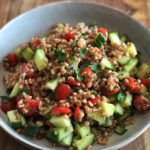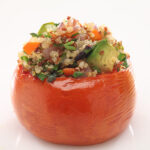With the entire grain kernel intact, whole grains contain more fiber, protein and other key nutrients than their refined (“white”) counterparts. Eating whole grains has been associated with lower risk of chronic diseases such as diabetes and heart disease and better weight maintenance.
did you know?
- A serving of whole grains is one ounce, or about: 1/2 cup of cooked grains, 1 slice of bread, 1 cup of cold cereal.
- Giving up gluten doesn’t mean giving up grains. Whole grains without gluten include Amaranth, Buckwheat, Corn, Millet, Quinoa, Rice, Sorghum, Teff and Wild Rice.
- Make half of your grains whole! Eat whole grains with half of your meals and snacks, or choose foods that are at least 50% whole grain.
- What is Freekeh (pronounced free-kuh)? According to legend, Freekeh originated by accident when an ancient village was attacked and their young wheat fields were set ablaze. In attempts to salvage their crops, the villagers rubbed away the burnt chaff and found that the roasted kernels inside were delicious! Since that time, Freekeh (which literally means, “to rub”) became a mainstay of Middle Eastern and Mediterranean cuisine.
- When shopping for grains, look for the Whole Grain stamp which will let you know just how much whole grain is in a product.
Want even more information about whole grains? Visit the Whole Grains Council.
try some of our favorite whole grain recipes
Farro Tabbouleh
Farro tabbouleh with cucumber, parsley, mint, tomatoes and lemon juice.
Check out this recipe

Sorghum and Lentil Power Bowl
Super tasty and power packed bowl with a turmeric dressing and fresh raspberries
Check out this recipe

Quinoa Stuffed Tomato
fresh tomatoes stuffed with quinoa, carrots, onions, eggplant, bell peppers, and avocado
Check out this recipe





Leave a Reply
You must be logged in to post a comment.